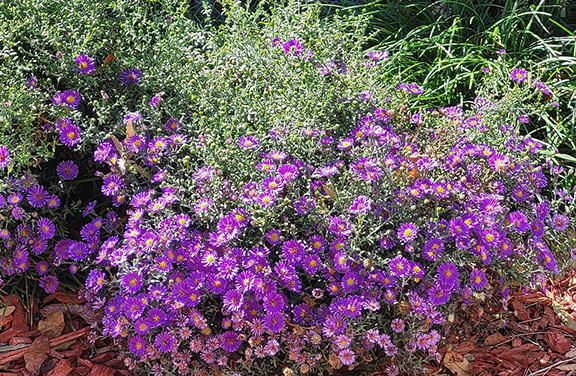Welcome!

Fall asters can make a long-lasting statement in the late-season garden. As an added bonus, the butterflies and bees will appreciate the lingering blossoms as they snack their way through October and November.
Time to fall for asters
Like a lot of folks, when I stopped by the garden center recently, I filled the back of my truck up with packs of pansies. Pansies (Viola × wittrockiana) are ubiquitous in fall whether you like the Panda-faced varieties, the clear or mono-colored ones, or the little relative of the wild violet, V. tricolor.
I didn’t mean to walk by the fall asters (Symphyotrichum novae-angliae) as I browsed for an assortment of colors in the pansy aisle. I just wasn’t thinking. We all have our go-to’s in the garden, like vincas and impatiens in summer. In the fall for me, it’s pansies and ornamental kale.
So it wasn’t until I visited a local restaurant later in the day that I spotted a lovely planting of asters. Crap, I thought to myself, now I have to go back to the garden center!
Asters give us plenty of reasons to add them to our garden beds. They are perennial — which means once they are in the flower border, you don’t have to worry about replacing them every year. They are low maintenance, once rooted in, and cold hardy. The flowers are daisy-like and typically about the size of a quarter to 50-cent piece. They last a long time in the flower border or in the flower vase.
As an added bonus, butterflies and bees flock to them as a late-season food source.
The biggest problem is soil that is too damp or compacted. Also, despite what some garden sources tell you, fall asters don’t like to bake in the full sun of summer in our area or further South. It’s best to give them a spot that gets protection from the harsh afternoon sun or that gets high, dappled shade throughout the day.
Aromatic aster (or S. oblongifolium) is recommended for the South, but good luck finding it. You are more likely to find the New England aster (S. novae-angliae) or blue wood aster (S. cordifolium). New England asters come in a range of colors from magenta to deep purple. Despite their name, blue wood asters also come in white.
It should be noted that that you can also find specialty garden centers and catalogs that sell Asian and European asters, but these tend to be the ones that bloom in spring and summer. Not that there’s anything wrong with that.
Also, for the record, if you search companies like Plant Delights Nursery, you’ll find a Carolina native called Carolina aster (S. carolinianum). I’ve never tried growing it and don’t think I’ve seen it in the wild, although it is said to be out there. It might make an interesting addition to your collection, especially if you like unusual plants. It is actually a vining aster.
Here’s one other thought about asters. If you like tidy little groupings of flowers, you might find asters a bit rowdy. As anyone who has appreciated a wild stand of asters in October will tell you, asters are in their glory when you can let them bloom in drifts. They will hold their flowers for a long time, even through the first few frosts of fall. So, maybe you can just let them have their way — at least until Old Man Frost moves in to stay.
